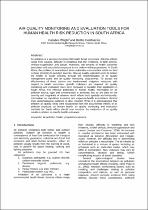 ResearchSpace
ResearchSpace
Air quality monitoring and evaluation tools for human health risk reduction in South Africa
JavaScript is disabled for your browser. Some features of this site may not work without it.
- ResearchSpace
- →
- Research Publications/Outputs
- →
- Conference Publications
- →
- View Item
| dc.contributor.author |
Wright, C

|
|
| dc.contributor.author |
Oosthuizen, R

|
|
| dc.date.accessioned | 2009-12-03T14:00:34Z | |
| dc.date.available | 2009-12-03T14:00:34Z | |
| dc.date.issued | 2009-10 | |
| dc.identifier.citation | Wright, C and Oosthuizen, R. 2009. Air quality monitoring and evaluation tools for human health risk reduction in South Africa. National Association for Clean Air Conference (NACA 2009). Vanderbijlpark, South Africa, 14-16 October 2009, pp 6 | en |
| dc.identifier.uri | http://hdl.handle.net/10204/3797 | |
| dc.description | National Association for Clean Air Conference (NACA 2009). Vanderbijlpark, South Africa, 14-16 October 2009 | en |
| dc.description.abstract | Air pollution is a serious environmental health threat to humans. Adverse effects range from nausea, difficulty in breathing and skin irritations, to birth defects, immuno-suppression and cancer. Moreover, the severity of health outcomes associated with air pollution exposure is not uniform within populations. In South Africa, the problem is exacerbated since vulnerable communities reside on land in close proximity to pollution sources. New air quality legislation aims to protect the health of South Africans through the implementation of air quality management plans and air quality monitoring programmes. To assess the effectiveness of these actions and implemented mitigation measures with respect to health outcomes, specific indicators are required. Air quality monitoring and evaluation tools were reviewed to consider their application in South Africa. For effective protection of human health, information on air pollution source, type and concentration is essential, but so are data on the severity and magnitude of adverse health effects both spatially and temporally. Information on population exposure and exposure-health associations derived from epidemiological evidence is also required. While it is acknowledged that ambient air quality limits were established from the documented effects of air pollution exposure on human health, air quality monitoring and evaluation methods for South Africa should also consider the evaluation of air quality results in relation to specific health outcomes. | en |
| dc.language.iso | en | en |
| dc.publisher | National Association for Clean Air Conference (NACA 2009) | en |
| dc.subject | Air quality monitoring | en |
| dc.subject | Air quality evaluation | en |
| dc.subject | Human health risks | en |
| dc.subject | Air pollution | en |
| dc.title | Air quality monitoring and evaluation tools for human health risk reduction in South Africa | en |
| dc.type | Conference Presentation | en |
| dc.identifier.apacitation | Wright, C., & Oosthuizen, R. (2009). Air quality monitoring and evaluation tools for human health risk reduction in South Africa. National Association for Clean Air Conference (NACA 2009). http://hdl.handle.net/10204/3797 | en_ZA |
| dc.identifier.chicagocitation | Wright, C, and R Oosthuizen. "Air quality monitoring and evaluation tools for human health risk reduction in South Africa." (2009): http://hdl.handle.net/10204/3797 | en_ZA |
| dc.identifier.vancouvercitation | Wright C, Oosthuizen R, Air quality monitoring and evaluation tools for human health risk reduction in South Africa; National Association for Clean Air Conference (NACA 2009); 2009. http://hdl.handle.net/10204/3797 . | en_ZA |
| dc.identifier.ris | TY - Conference Presentation AU - Wright, C AU - Oosthuizen, R AB - Air pollution is a serious environmental health threat to humans. Adverse effects range from nausea, difficulty in breathing and skin irritations, to birth defects, immuno-suppression and cancer. Moreover, the severity of health outcomes associated with air pollution exposure is not uniform within populations. In South Africa, the problem is exacerbated since vulnerable communities reside on land in close proximity to pollution sources. New air quality legislation aims to protect the health of South Africans through the implementation of air quality management plans and air quality monitoring programmes. To assess the effectiveness of these actions and implemented mitigation measures with respect to health outcomes, specific indicators are required. Air quality monitoring and evaluation tools were reviewed to consider their application in South Africa. For effective protection of human health, information on air pollution source, type and concentration is essential, but so are data on the severity and magnitude of adverse health effects both spatially and temporally. Information on population exposure and exposure-health associations derived from epidemiological evidence is also required. While it is acknowledged that ambient air quality limits were established from the documented effects of air pollution exposure on human health, air quality monitoring and evaluation methods for South Africa should also consider the evaluation of air quality results in relation to specific health outcomes. DA - 2009-10 DB - ResearchSpace DP - CSIR KW - Air quality monitoring KW - Air quality evaluation KW - Human health risks KW - Air pollution LK - https://researchspace.csir.co.za PY - 2009 T1 - Air quality monitoring and evaluation tools for human health risk reduction in South Africa TI - Air quality monitoring and evaluation tools for human health risk reduction in South Africa UR - http://hdl.handle.net/10204/3797 ER - | en_ZA |





